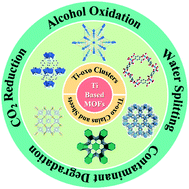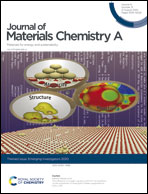From isolated Ti-oxo clusters to infinite Ti-oxo chains and sheets: recent advances in photoactive Ti-based MOFs
Abstract
Metal–organic frameworks (MOFs) have emerged as a significant class of porous crystalline materials constructed from metal nodes and multidentate linkers. Many research studies have shown the promising applications of MOFs in gas adsorption and separation, electrocatalysis, photocatalysis, biomedicine etc., mainly due to the advantages of high porosity, large surface areas and easily tunable optical and electronic structures. Particularly, light-sensitive Ti-oxo clusters in Ti-based MOFs result in promising photocatalytic activity. Recently, a few Ti–carboxylate MOFs based on infinite Ti-oxo chains and sheets were reported, which open a new horizon for the photocatalytic activity of Ti-MOF chemistry. This review highlights some typical Ti-MOFs based on discrete Ti-oxo clusters and recent progress in the fabrication of Ti-MOFs based on infinite Ti-oxo chains and sheets. Moreover, facile modification methods for improving the photocatalytic activity under visible light irradiation are exemplified in detail. We hope that the photocatalytic applications of Ti-MOFs in photocatalytic H2 generation, photocatalytic reduction of CO2, dye photodegradation, photocatalytic alcohol oxidation and photocatalytic polymerization will benefit researchers who are interested in this field.

- This article is part of the themed collections: 10th Anniversary: Dedicated Authors and Journal of Materials Chemistry A Emerging Investigators


 Please wait while we load your content...
Please wait while we load your content...